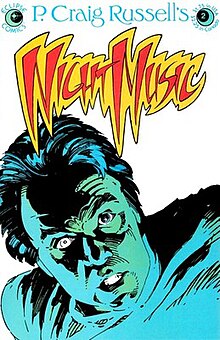Night Music (comic)
| Night Music | |
|---|---|
 The cover to Night Music #2, art by P. Craig Russell. | |
| Publication information | |
| Publisher | Eclipse Comics |
| Schedule | Irregular |
| Publication date | November 1979 – October 1989 |
| No. of issues | 1 graphic novel 11 issues |
| Creative team | |
| Created by | P. Craig Russell |
| Written by | P. Craig Russell |
| Artist(s) | P. Craig Russell |
| Colorist(s) | P. Craig Russell |
| Editor(s) | Cat Yronwoode |
Night Music is an American comic book anthology created by artist P. Craig Russell, published by Eclipse Comics. It consists of comic adaptations of operas, novels, classical music and poems, and followed an irregular publishing model that changed formats according to the needs of the material.
Publication history
[edit]Russell had collaborated with Don McGregor for Marvel Comics, and the writer put him in contact with the newly-formed Eclipse Enterprises founded by brothers Dean and Jan Mullaney in 1979, following their successful publication of McGregor's graphic novel Sabre: Slow Fade of an Endangered Species. A deal was soon struck allowing Russell to publish his plans for a series of experimental adaptations through Eclipse, while retaining ownership of his submissions.[1] A major factor was the high-quality printing method used by Eclipse for Saber.[2]
Graphic novel
[edit]The first piece in the series was the graphic novel Night Music 1, containing the stories "Breakdown on the Starship Remembrance" and "La Sonnambula", published in November 1979.
Comic series
[edit]In 1984 Russell returned to Eclipse after working for Marvel Comics, and made plans for an ongoing series of Night Music. The series would have a highly unusual structure; while covers and promotion of the various contents would use different titles and numbering, the publisher's indicia would mark it as an edition of the ongoing Night Music series. Russell himself would also number the stories within his 'opus' system, an ongoing personal index of all his works. The first three issues followed a 36-page anthology format; the second issue was delayed when Russell lost some of the artwork.;[3] it continued some of Russell's The Jungle Book adaptation began in Marvel Fanfare.[2] Following this Night Music was reformatted as an umbrella title for various adaptations. Pelleas and Melisandre was promoted as a two-issue micro-series issued bi-weekly in December 1984; each issue had 36 pages and contained half of the adaptation.[4] Salome was issued as a "one-issue micro-series",[5] and Red Dog as a one-shot.[6] For Ariane & Bluebeard the format changed to a 52-page one-shot,[7] and the final adaptation for Eclipse – Mozart's The Magic Flute – consisted of a three-issue prestige format limited series.[8]
| Issues | Date | Cover title | Contents |
|---|---|---|---|
| 1–3 | December 1984 – March 1985 | P. Craig Russell's Night Music #1–3 |
Issue 1 (December 1984):
Issue 2 (February 1985):
Issue 3 (March 1985):
|
| 4–5 | December 1985 | Pelleas & Melisande #1–2 |
|
| 6 | June 1986 | Salome #1 |
|
| 7 | February 1988 | Red Dog #1 |
|
| 8 | 1989 | Ariane & Bluebeard #1 |
52-page one-shot.
|
| 9–11 | August – October 1990 | The Magic Flute Book One – Book Three |
Three issue "prestige format" limited series, each 52 pages.
|
Reception
[edit]The series received consistent critical acclaim. Night Music was nominated for 'Best Finite Series' at the 1985 Kirby Awards,[9] and Pelleas & Melisande was nominated in the same category the following year,[10] but the works would lose out on both occasions to DC Comics' Crisis on Infinite Earths. The latter also earned Russell a nomination as 'Best Artist', but the award went to Steve Rude for Nexus.[11]
Reviewing Salome for Amazing Heroes, R.A. Jones called Russell "one of the most classically adept artists in all of comics" and called the issue "an artistic tour-de-force". [5] The adaptation was also nominated for 'Best Single Issue' at the 1987 Kirbys.[12][13] John Hartman evaluated Ariane & Bluebeard for Amazing Heroes in 1989, stating "if you have any sense at all, you will buy Ariane & Bluebeard", and declared Russell a "national treasure".[14]
References
[edit]- ^ Mullaney, Dean (w). "Ten Years After!" Total Eclipse, no. 1 (May 1988). Eclipse Comics.
- ^ a b Bob Hughes (June 1, 1988). "Enlarging the Penumbra". Amazing Heroes. No. 142. Fantagraphics Books.
- ^ "Newsflashes". Amazing Heroes. No. 64. Redbeard, Inc. February 1, 1985.
- ^ "Newsflashes". Amazing Heroes. No. 80. Fantagraphics Books. October 1, 1985.
- ^ a b R.A. Jones (July 1, 1986). "Comics in Review". Amazing Heroes. No. 98. Fantagraphics Books.
- ^ "Newsline". Amazing Heroes. No. 134. Fantagraphics Books. February 1, 1988.
- ^ "Top of the News (advertisement)". Amazing Heroes. No. 158. Fantagraphics Books. February 1, 1989.
- ^ "Newsline". Amazing Heroes. No. 180. Fantagraphics Books. June 1990.
- ^ "1985 Jack Kirby Awards". Hahn Library Comic Book Awards Almanac. Archived from the original on March 4, 2012.
- ^ "Newsline". Amazing Heroes. No. 96. Fantagraphics Books. June 1, 1986.
- ^ "1986 Jack Kirby Awards". Hahn Library Comic Book Awards Almanac. Archived from the original on March 4, 2012.
- ^ "The 1987 Jack Kirby Comic Industry Awards". Amazing Heroes. No. 119. Fantagraphics Books. June 15, 1987.
- ^ "1987 Jack Kirby Awards". Hahn Library Comic Book Awards Almanac. Archived from the original on March 4, 2012.
- ^ John Hartman (March 15, 1989). "Comics in Review". Amazing Heroes. No. 161. Fantagraphics Books.
External links
[edit]- Eclipse Comics titles
- 1979 comics debuts
- 1989 comics endings
- 1979 graphic novels
- 1984 comics debuts
- 1990 comics endings
- Adaptations of works by Maurice Maeterlinck
- Adaptations of works by Oscar Wilde
- Adaptations of works by Rudyard Kipling
- American comics
- Comics anthologies
- Comics publications
- Cultural depictions of Salome
- Works based on The Magic Flute
